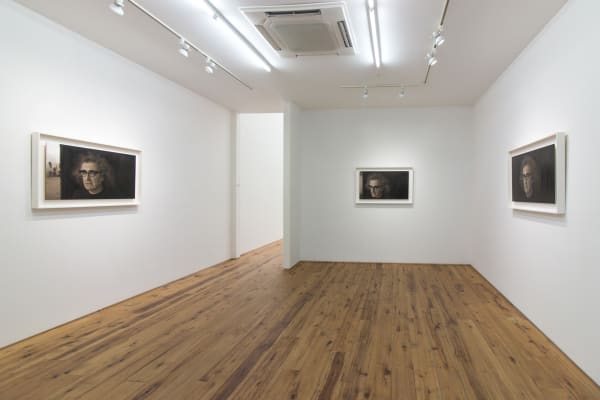The Incredible Likeness of Being
The gallery is proud to present The Incredible Likeness of Being, a group exhibition that investigates the ‘Self’ through new paintings by five international contemporary artists.
From the Early Renaissance by Jan Van Eyck to some of the leading artists such as Rembrandt, Velazquez, Van Gogh, Schiele and Kahlo, the self-portrait at its best is revelatory capturing the artist’s image and soul on canvas. Unlike Narcissus who died fixated at the beauty of his own reflection, the intent of Self-Portraiture is to traverse superficialities and provide a critical insight of the sitter’s identity.
In obedience to the Socratic statement ‘Know Thyself‘, the artist, while looking in the mirror to reproduce his physical appearance, is in fact giving the world a visual autobiographical story; an honest documentation of his period, environment and culture. In the works included in this show, a “likeness of being” demonstrates that so much more is achievable than modeling reality; it is the exposure of the inner psyche in a form that can only be expressed by the artist. Indeed, Rembrandt depicted himself in later years as the old, haggard and tired artist he was, near penniless, but with only paint, Rembrandt achieved a level of verity no photograph could. His student Samuel van Hoogstraten would go on to advise artists: “Benefit can be gained from the depiction of your own passions, especially in front of a mirror, where you are simultaneously the creator and the spectator.”
The Israeli hyper-realist Yigal Ozeri is well known for his paintings of beautiful women caught in the fleeting moment of bliss amidst oneiric landscapes. In these self-portraits idyllic nature has disappeared ─ for the first time in his career Ozeri creates works that lay bare his soul. By painting from images captured by renowned photographer Mark Berghash, Ozeri’s black and white somber self-portraits portray a man vulnerable and introspective. These paintings benchmark Ozeri as one of today’s best photorealist painters.
For his self-examination, American artist Sam Trioli too uses stills by Berghash. Having recently painted grave monochromatic portraits of Harry and Bess Truman, Trioli is no stranger to Grisaille. With a keen attention to the tactility of the surface, he uses a combination of addition and removal of paint to give form to the image. The exposed bright canvas becomes the highlights in his Chiaroscuro-tinged face. Trioli’s self-portrait paintings exist both as uncanny representational images and palpable painted objects.
Zlatan Vehabović, a highly regarded young Croatian artist earned his Ph.D. in painting at the vaunted Academy of Fine Arts in Zagreb. Here Vehabović dials up the psychological drama in various profiles, each loaded with their respective intensity. Facing away from the viewer, Vehabović is caught in an ambiguous emotional state. Facing the viewer head on, his glare is direct. Rendered in quivering but beautiful brushstrokes, these self-portraits with their ominous gray atmospheric backgrounds likely capture the artist’s current mood.
British artist Richard Wathen is widely known for his portraits, classically closer to Thomas Gainsborough and Watteau, but imbued with a sense of enigmatic uneasiness and illusions of familiarity. In his most renowned and charged work a naked boy is holding a rabbit. The ‘Wathens’ isolated here are represented as women, perhaps to displace the viewer’s instinct to judge the technicalities of the artist too quickly. As a result, these are complex allegories of an imagined ‘Self’. In a full-length figure draped in a paint-stained dress, the artist embodies both the subject and the muse. In another disquieting depiction, ‘Wathen’ coyly plays with a pipe – the bubbles that float in the foreground distort the reality of his features.
In Erika Harrsch’s ensemble of mixed-media Self-Portrait paintings, she explores issues of identity through her different cultural lenses, depicting the (her) female body connected to elements of animal anatomy, both mammals or insects, with eroticized sketches and a diversity of media associated with opulence and sensuality. Solid forms and silhouettes constantly collide, and are further transformed through the multiple and simultaneous symbolic relationships found in the collage.
Giorgio Vasari’s Lives Of The Artists opened the doors for practitioners to rightfully be recognized as artists, perhaps igniting the desire to present themselves to the outside world, recording their existence in history. The phenomenon of Self-Portraiture continues to be a formidable theme for contemporary artists today. In the age of the instant ‘Selfie’, a demand for a slower, more cerebral practice is ever more necessary.
The Incredible Likeness Of Being features new works by Yigal Ozeri, Sam Trioli, Zlatan Vehabović, Erika Harrsch and Richard Wathen.




